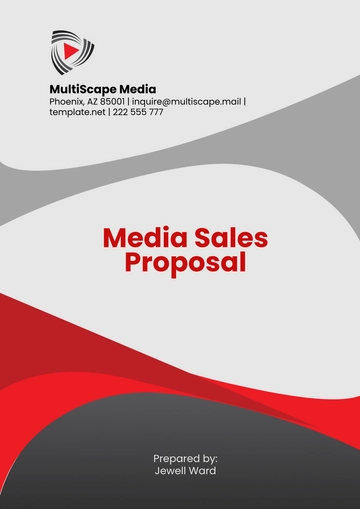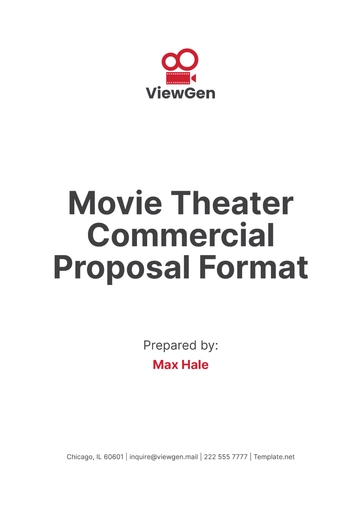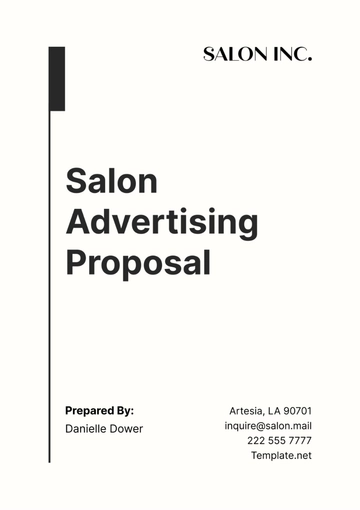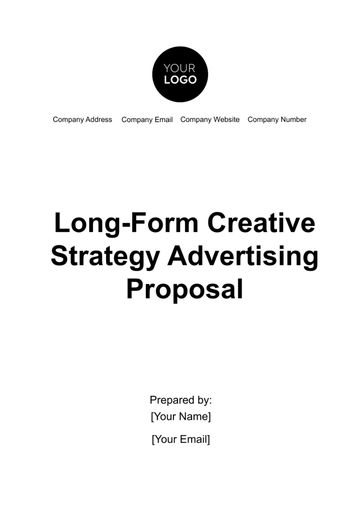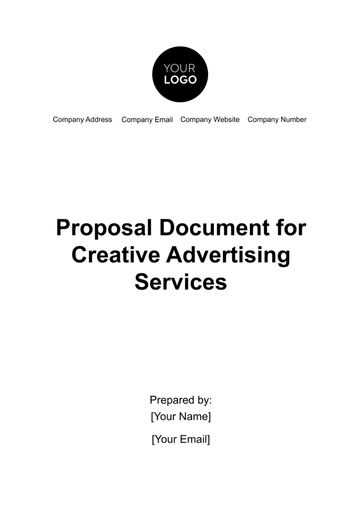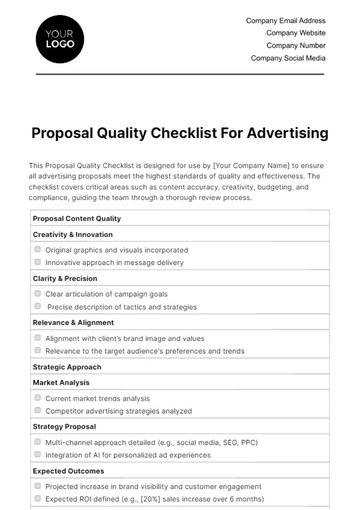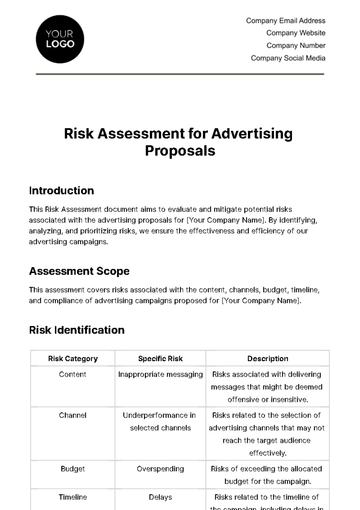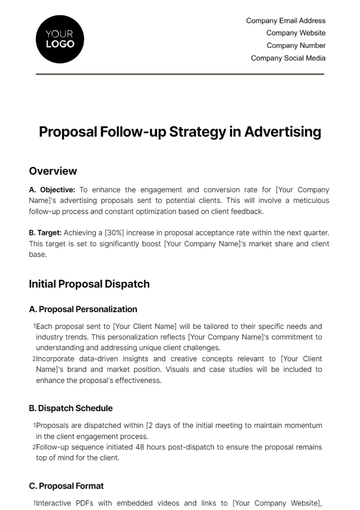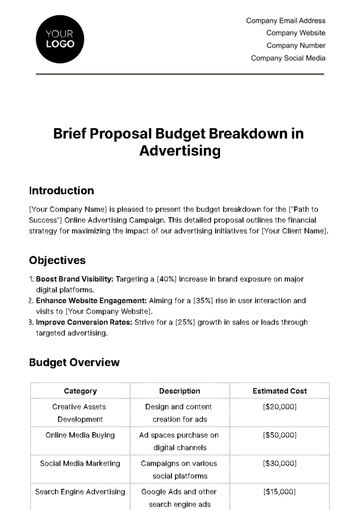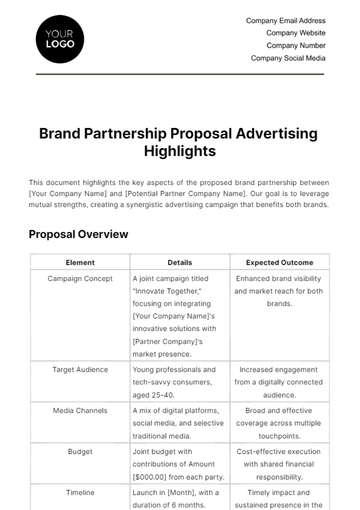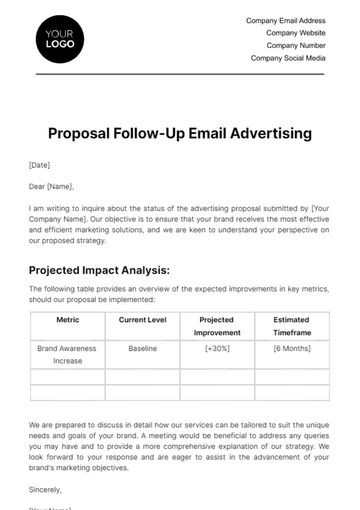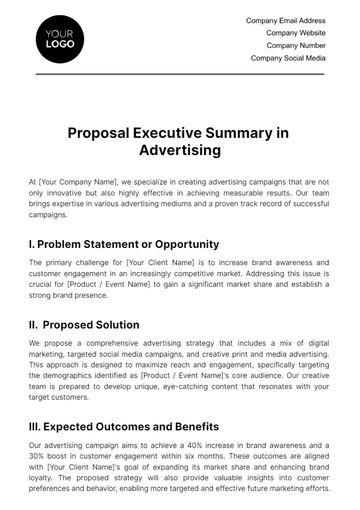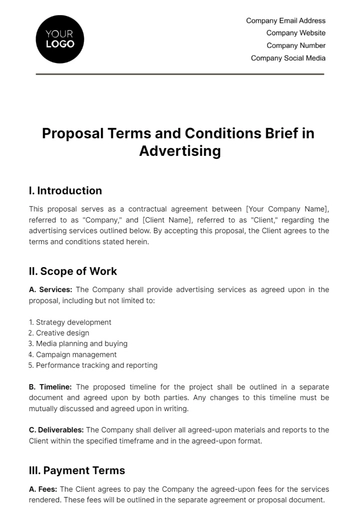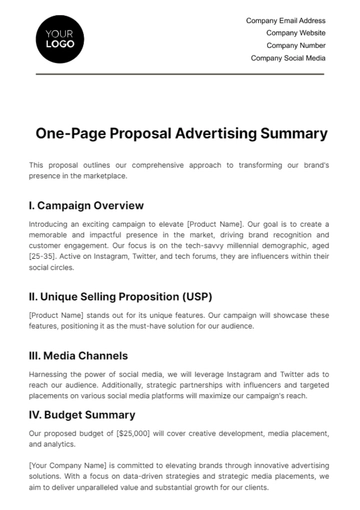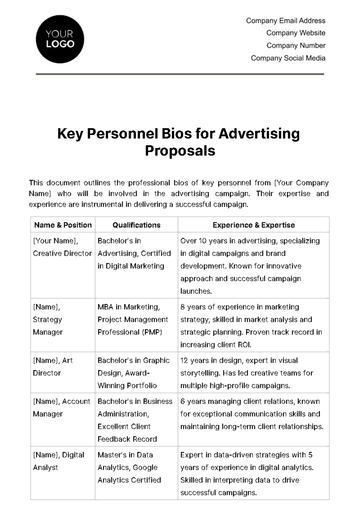Free Proposal for Advertising Research and Insights

I. Executive Summary
Our advertising research and insights proposal is designed to unlock deep understanding of consumer behaviors and preferences, vital for crafting effective advertising campaigns. We aim to blend quantitative and qualitative research approaches to offer a robust analysis of the market and consumer trends. This proposal outlines our strategic approach to collecting and analyzing data to improve advertising effectiveness and brand positioning.
II. Background and Introduction
Industry Landscape and Challenges: The advertising landscape is increasingly competitive and consumer preferences are rapidly evolving. Our research aims to delve into these dynamics, offering insights into how our brand can stand out.
Company Positioning: Currently, our brand holds a moderate market share in the home electronics sector. Our previous advertising campaigns have focused on product features, but there's a need to shift towards more lifestyle-oriented messaging.
III. Research Objectives
The primary objective is to gain a comprehensive understanding of consumer buying patterns, brand perception, and advertising recall. A secondary goal is to identify unexplored market segments and new advertising opportunities, particularly in emerging digital platforms.
IV. Methodology
Quantitative Research:
Survey Design: A structured questionnaire will be developed, targeting 1,000 participants across key demographics. Questions will focus on advertising recall, brand perception, and purchasing influencers.
Data Analysis: Utilizing statistical tools, we will conduct a thorough analysis of the survey data to identify trends and patterns.
Qualitative Research:
Focus Groups: We will conduct six focus group sessions, each consisting of 8-10 participants from diverse backgrounds, to gather nuanced insights into consumer attitudes towards advertising.
In-depth Interviews: Interviews with 15 market influencers will provide deeper understanding of market trends and consumer expectations.
V. Target Audience Analysis
A. Comprehensive Audience Profiling
Understanding the target audience is crucial for tailoring our advertising strategies. This section focuses on developing a multi-dimensional profile of our primary audience segments.
B. Demographic Analysis
Age Groups: We are focusing on two key age demographics: 25-35 years and 36-50 years. These groups represent our core user base and potential customers.
Gender Breakdown: The products have universal appeal, but we will investigate gender-specific preferences in advertising tone and content.
Income Levels: Middle to upper-middle income levels are our primary focus, aligning with the pricing and positioning of our products.
C. Psychographic Profiling
Lifestyles and Interests: Emphasizing on individuals who value technology in enhancing lifestyle and efficiency. Interest in smart home technology is a key marker.
Values and Attitudes: Environmental consciousness and a preference for innovative, reliable products will be key factors in our messaging.
D. Behavioral Insights
Purchasing Behaviors: We will analyze patterns such as online shopping frequency, brand loyalty, and responsiveness to advertising.
Media Consumption Habits: Understanding their preferred media channels for both information and entertainment is critical in deciding our advertising mediums.
Target Audience Segmentation Table
Segment | Age Range | Key Interests | Preferred Media Channels | Notable Behaviors |
Tech-Savvy Professionals | 25-35 | Technology, Efficiency | Online Platforms, Social Media | High online engagement, brand conscious |
Mature Homeowners | 36-50 | Home Improvement, Innovation | TV, Magazines | Brand loyalty, look for reliability |
E. Anticipated Adjustments in Advertising
Based on the analysis, we might need to adjust our advertising tone, channels, and content to better align with the identified preferences and behaviors of our target audience.
VI. Competitive Analysis
A. Overview of Competitive Landscape
In this rapidly evolving electronics market, our competitors are employing diverse advertising strategies to capture consumer attention. This section aims to dissect their approaches to understand what works and where gaps exist.
B. Direct Competitors Analysis
Brand X: Known for their emotive storytelling in advertising, focusing on how their products fit into a modern lifestyle. We will analyze their recent TV and social media campaigns for engagement metrics and consumer responses.
Brand Y: Leverages price-based advertising, often using aggressive promotional tactics. Their digital ad spends and ROI will be scrutinized to understand the effectiveness of such strategies.
C. Indirect Competitors and Emerging Trends
Emerging Brands: New entrants in the market are utilizing influencer marketing and grassroots digital campaigns. Understanding their tactics can offer insights into newer, potentially more cost-effective advertising methods.
Market Trends: Identification of broader market trends, such as the shift towards eco-friendly products, which could influence future advertising approaches.
Competitive Strategies Table
Competitor | Advertising Medium | Key Messaging | Estimated Reach | Consumer Response |
Brand X | TV, Social Media | Social Media, Influencer | High | Positive |
Brand Y | Online Ads, Email | Price Promotions | Moderate | Mixed |
Emerging Brands | Social Media, Influencer | Innovation, Accessibility | Growing | Highly Positive |
VII. Advertising Channels Assessment
A. Assessment of Current Channels
Our current advertising channels span both traditional and digital media. This assessment will evaluate their effectiveness in terms of reach, engagement, and ROI.
B. Traditional Media Effectiveness
Television: Despite high costs, our TV ads have shown significant reach but varying engagement levels. An in-depth analysis of viewer demographics and time slots will be conducted.
Print Media: The impact of print media advertisements in industry-specific magazines and local newspapers will be evaluated for market penetration and recall rate.
C. Digital Media Performance
Social Media Platforms: Platforms like Facebook, Instagram, and Twitter have been primary channels for our digital advertising. We'll assess metrics like click-through rates, engagement rates, and demographic reach.
Search Engine Marketing: The effectiveness of our SEO and SEM strategies will be examined to understand their contribution to website traffic and lead generation.
Channel Performance Table
Advertising Channel | Metrics Analyzed | 2022 Performance | Target Audience | Adjustments Proposed |
Television | Reach, Engagement | High Reach, Medium Engagement | Adults 25-45 | Refine time slots |
Print Media | Recall Rate, Penetration | Moderate Recall, High Penetration | Adults 35+ | Increase niche magazine presence |
Social Media | CTR, Engagement Rate | High CTR, Varied Engagement | Young Adults 18-34 | Enhance content strategy |
SEM | Website Traffic, Lead Generation | Moderate Traffic, High Lead Quality | Adults 25-45 | Optimize keyword strategy |
VIII. Timeline and Milestones
A. Project Phases Overview
This project is structured into distinct phases, each with its own set of goals and deliverables, ensuring a streamlined and efficient research process.
Phase | Description | Estimated Timeframe | Key Deliverables |
Research Planning | Development of research objectives and methodologies | 1 Month | Research plan and methodology outline |
Data Collection | Conducting surveys, focus groups, and interviews | 3 Months | Raw data collection |
Data Analysis | Processing and analyzing collected data | 2 Months | Preliminary findings and data interpretations |
Report Drafting | Compiling findings into a comprehensive report | 1 Month | Draft report for internal review |
Finalization and Presentation | Reviewing, finalizing, and presenting the report | 1 Month | Final report and presentation materials |
B. Milestone Tracking
Regular updates will be provided at the end of each phase, ensuring that the project stays on track and any issues are addressed promptly.
IX. Budget and Resource Allocation
A. Budget Overview
A comprehensive budget plan is essential for the effective allocation of resources and ensuring that all research activities are well-funded.
Detailed Budget Breakdown
Item | Description | Estimated Cost |
Personnel | Salaries for research team members | $100,000 |
Survey and Data Collection | Tools and platforms for data collection | $50,000 |
Focus Groups and Interviews | Venue rental, incentives for participants | $30,000 |
Data Analysis Tools | Software for data processing and analysis | $20,000 |
Report Production | Printing and materials for the final report | $10,000 |
Total | $210,000 |
B. Resource Management
Efficient management of both human and material resources will be a key focus, ensuring the project is completed within the allocated budget.
X. Expected Outcomes and Benefits
A. Anticipated Research Outcomes
In-depth Consumer Insights: Understanding of consumer behaviors, preferences, and responses to different advertising strategies.
Market Positioning Strategies: Recommendations for positioning our brand more effectively in the market.
Advertising Channel Efficacy: Insights into the most effective channels for reaching our target audience.
B. Strategic Benefits
Enhanced Advertising Effectiveness: More targeted and impactful advertising campaigns, leading to better ROI.
Competitive Edge: Strategic advantages over competitors through informed decision-making.
Future Growth Opportunities: Identification of new market segments and advertising opportunities.
Benefit Category | Description | Expected Impact |
Market Understanding | Deeper insights into consumer needs and trends | High |
Advertising Strategy | Development of more effective advertising campaigns | Significant |
Competitive Positioning | Gaining an edge over competitors through strategic insights | Moderate |
- 100% Customizable, free editor
- Access 1 Million+ Templates, photo’s & graphics
- Download or share as a template
- Click and replace photos, graphics, text, backgrounds
- Resize, crop, AI write & more
- Access advanced editor
Introducing Template.net's Proposal for Advertising Research and Insights Template. This editable and customizable proposal, designed with our Ai Editor Tool, facilitates comprehensive research and insights gathering for effective advertising strategies. Elevate your campaigns with data-driven decisions. Streamline your advertising research process with Template.net's innovative solutions.
You may also like
- Business Proposal
- Research Proposal
- Proposal Request
- Project Proposal
- Grant Proposal
- Photography Proposal
- Job Proposal
- Budget Proposal
- Marketing Proposal
- Branding Proposal
- Advertising Proposal
- Sales Proposal
- Startup Proposal
- Event Proposal
- Creative Proposal
- Restaurant Proposal
- Blank Proposal
- One Page Proposal
- Proposal Report
- IT Proposal
- Non Profit Proposal
- Training Proposal
- Construction Proposal
- School Proposal
- Cleaning Proposal
- Contract Proposal
- HR Proposal
- Travel Agency Proposal
- Small Business Proposal
- Investment Proposal
- Bid Proposal
- Retail Business Proposal
- Sponsorship Proposal
- Academic Proposal
- Partnership Proposal
- Work Proposal
- Agency Proposal
- University Proposal
- Accounting Proposal
- Real Estate Proposal
- Hotel Proposal
- Product Proposal
- Advertising Agency Proposal
- Development Proposal
- Loan Proposal
- Website Proposal
- Nursing Home Proposal
- Financial Proposal
- Salon Proposal
- Freelancer Proposal
- Funding Proposal
- Work from Home Proposal
- Company Proposal
- Consulting Proposal
- Educational Proposal
- Construction Bid Proposal
- Interior Design Proposal
- New Product Proposal
- Sports Proposal
- Corporate Proposal
- Food Proposal
- Property Proposal
- Maintenance Proposal
- Purchase Proposal
- Rental Proposal
- Recruitment Proposal
- Social Media Proposal
- Travel Proposal
- Trip Proposal
- Software Proposal
- Conference Proposal
- Graphic Design Proposal
- Law Firm Proposal
- Medical Proposal
- Music Proposal
- Pricing Proposal
- SEO Proposal
- Strategy Proposal
- Technical Proposal
- Coaching Proposal
- Ecommerce Proposal
- Fundraising Proposal
- Landscaping Proposal
- Charity Proposal
- Contractor Proposal
- Exhibition Proposal
- Art Proposal
- Mobile Proposal
- Equipment Proposal
- Student Proposal
- Engineering Proposal
- Business Proposal

